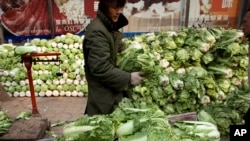A cabbage crop being grown on a tropical islet will help China solidify its claims in a wider, disputed Asian sea by allowing more people to live there and proving that the tiny feature can sustain itself.
Chinese navy personnel last month harvested 750 kilograms of crops on Woody Island in the South China Sea’s Paracel archipelago, Beijing-based Global Times online reported. The personnel used domestically developed “sand-to-earth” technology to grow bok choy cabbage, baby cabbage and lettuce among other vegetables, the news outlet says.
Vietnam and Taiwan claim the same islets as well as the surrounding sea. Further south in the 3.5 million-square-kilometer waterway, Brunei, Malaysia and the Philippines compete with Chinese claims in the Spratly Islands. Rival governments prize much of the sea for fish and energy reserves. China has taken a military lead over the other parties since 2010.
The crop will help China prove economic activity on a disputed island, a plus in its search for an internationally recognized legal basis to control the Paracels ,scholars believe.
“Other than military usage, you need to do something substantive in order to bolster your sovereignty claims,” said Oh Ei Sun, senior fellow with the Singapore Institute of International Affairs. “You need to do something which can advance (the) so-called local economy.”
Technology behind China’s crop on Woody Island can “support communities” there, the Global Times said, citing experts. About 1,000 people already live on the islet. They rely largely on food shipments from mainland China.
The Permanent Court of International Justice considers a continual display of authority over a land feature as an effective administrative use of the South China Sea.
China lost a world court arbitration case in 2016 to the Philippines over the legal basis for its maritime sovereignty claims. Officials in Beijing cited historical records to argue that about 90% of the waters belong to them.
China’s installation of hangars and radar equipment on some islets – following a multi-year land reclamation effort – had alarmed Manila among other claimants.
The farming breakthrough on Woody Island goes against a court statement in 2016 that islands in the sea could not support “communities of their own”, the Chinese government-run Global Times said.
“You can factor this in as part of a holistic strategy to demonstrate habitation capability,” said Alan Chong, associate professor at the S. Rajaratnam School of International Studies in Singapore.
Taiwan, Vietnam and the Philippines have promoted crop planting on islands under their control in the contested sea but without any clear legal gains, analysts say.
Taiwan ex-president Ma Ying-jeou argued in 2016 that the consumption of corn, sweet potatoes and chickens raised on Taiping Island in the Spratly chain proved that the Taiwanese coast guard-administered feature could support a human population. The islet is therefore entitled to a 200-nautical-mile exclusive economic zone in the sea around it, Ma said.
Some of the 300 Filipinos living on Thitu Island in the same chain plant their own crops. Vietnamese strive to raise crops on South China Sea islets under their control, said Carl Thayer, emeritus professor at the University of New South Wales in Australia.
China had grown crops on its maritime holding even before the recent cabbage harvest announcement, he said.
Eventually, farming will run up against a lack of space given each islet’s tiny size and competing land uses such as human habitation, he suggested. “Where is the crossover point where you can make enough to feed everyone on the island and significantly reduce the imports?” Thayer asked. “I’m being skeptical that we’re making a leap.”




